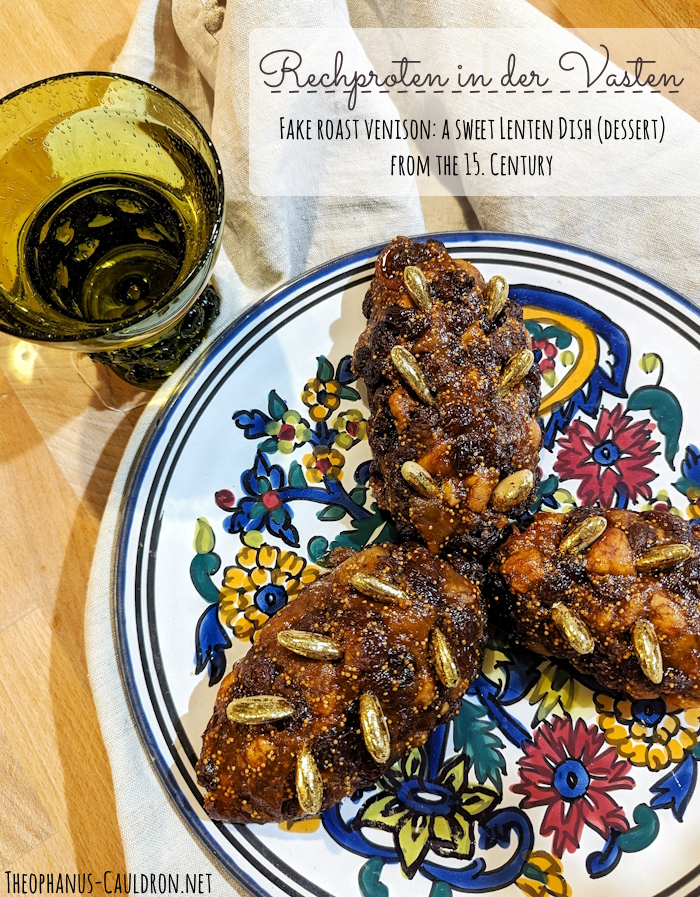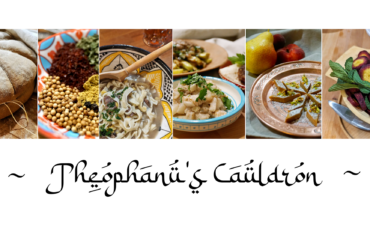How it happend that I covered myself, my child and large parts of my kitchen with edible gold. Or: Experimental (food-)archaeology and my reconstruction of a pretentious noble Lenten dish from the 15th century!
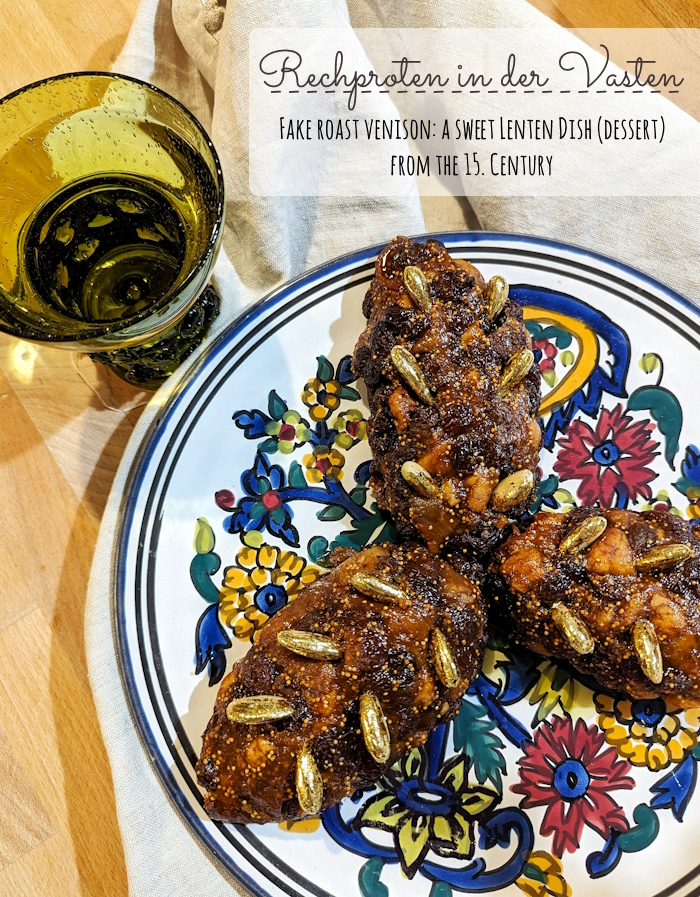
The dessert recipe for a sweet, vegetarian/vegan roast made from dried fruits and almonds comes from the recipe book “Küchenmeisterei” from Nuremberg, first printed in 1485 and therefore it’s (all cookbook addicts please take a deep breath!) the first printed, German-language cookbook! Isn’t that intriguing?
As it is usually the case with medieval recipes – at least with most European ones – the information on quantities, preparations and cooking times are rather scarce. It was assumed that this was all somehow general knowledge. And don’t forget: These were the first steps into the cookbook industry and the target audience did not consist of beginner cooks.
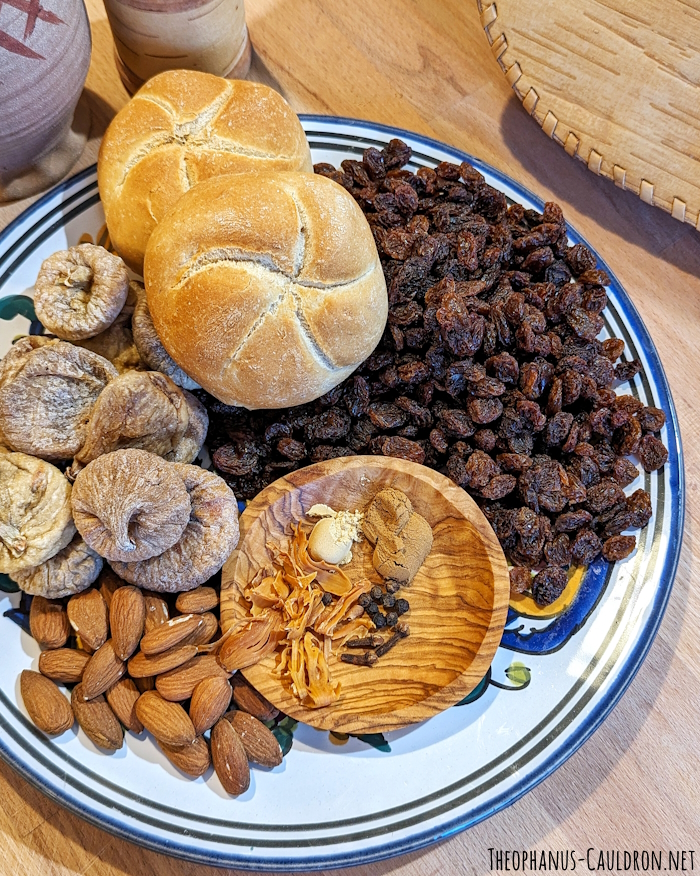
Christian, German Lenten dishes in the Middle Ages
And so my recipe for fake roast venison, based on the recipe “Holbroten” or “Rechproten in der vasten” (read: roast venison during Lent), has also to be seen with a lot of room for interpretation.
“Holbroten” apparently means something like “hollow roast”, since there was a skewer stuck in the meat which later formed a cavity. Think of suckling pig – only in vegetarian terms. If the clarified butter, which is optional in the recipe, is omitted, it is even a vegan dessert. And even though noble (and damn expensive for the time) ingredients come together here, such as spices, almonds, dried fruits, sugar, white bread and fresh ginger (at that time of year!), formally everything for a Christian Lenten dish was fulfilled. Tricky, huh?
The Christian period of fasting used to be interpreted as strictly as the Islamic Ramadan. There was only one meal a day and this was also broken down in terms of content by avoiding certain types of meat, dairy products and eggs. The fact that the recipe called for (optional) clarified butter initially irritated me a bit, until I stumbled upon the fact that cities or regions could obtain fasting dispensations from the Pope. This means they could get an easement, that allowed them, for example, to eat dairy products during Lent. And even though the cookbook “Küchenmeisterei” was not written in Nuremberg, but only published there in printed form, I found it extremely fascinating to read in this blog article on the subject of the Christian Lent in the Middle Ages that Nuremberg obtained a fasting dispensation in 1437 so that the poorer population could consume dairy products. And that in 1445 Pope Eugene IV. extended permission to consume butter to the entire city population by means of a so-called “Butterbrief” (butter letter).
So in summary and apart from the butter: If you were rich, you could be a well-behaved, proper, good christian person by using luxurious ingredients and at the same time show off your wealth in a spectacular fashion.
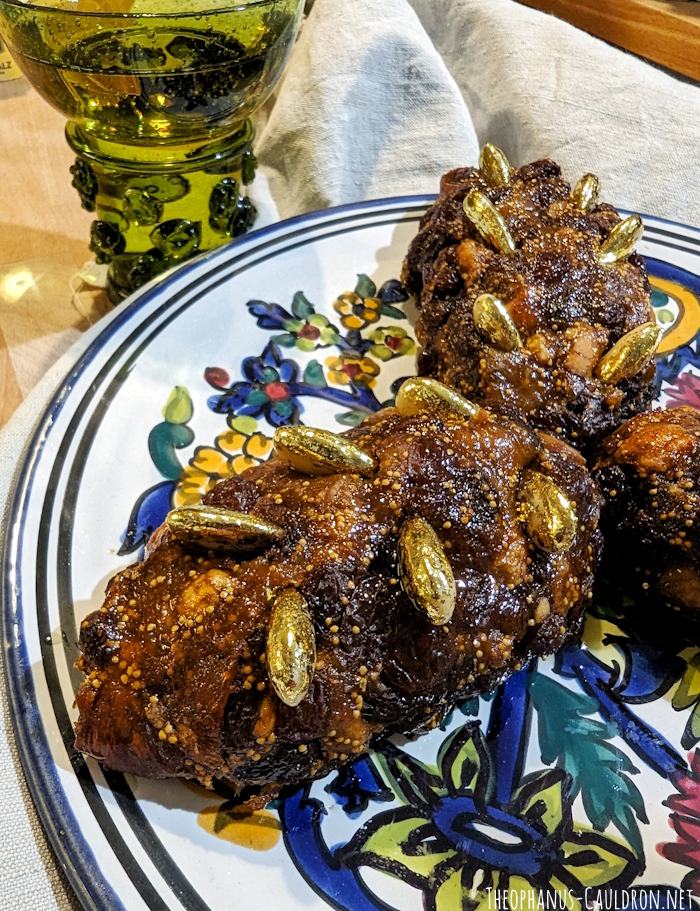
The first printed German cookbook: Küchenmeisterei from Nuremberg, 1485
Unfortunately, there is little information to be found about this first printed (!) German-language cookbook on the internet. It comes from an anonymous author, was published by Peter Wagner in 1485 as “Kuchemeysterey” and continued to be distributed as a successful printed work in the following two centuries. This is not rural cuisine, but rather very upscale, fine, perhaps even courtly cuisine. As with the Arabic recipe books from much earlier times, precious ingredients are used here and, among other things, dishes are artistically colored. There are also instructions for gilding almonds to be found. (The book recommends making wooden scissors for applying gold leaf. I fiddled around with tweezers, but my edible fake gold behaved differently, which is why my kitchen table still glitters golden in places!) There also exist older manuscripts on this subject, the medievalist Trude Ehlert focuses in her book Küchenmeisterei. Edition, Übersetzung und Kommentar zweier Kochbuch-Handschriften des 15. Jahrhunderts* on two of these.
And thanks to the wonders of the Internet, you can take a look at the printed work yourself; a copy of the “Kuchemeysterey” from 1486 is in the possession of the Staatsbibliothek zu Berlin/Preußischer Kulturbesitz, Berlin and so it has been scanned and is freely available.
I’m poaching a little outside of my expertise here, that’s because the KochKulturMuseum on Instagram invites to an online cooking party once a month, with a preserved recipe from human history as a challenge. This then needs to be interpreted on your own stove. In February, the choice fell on one of the first recipes from the Küchenmeisterei. (Here you can find out more about the Austrian company KoKuMu, which offers cooking courses from Stone Age dishes and Jane Austen Picnics to Great Grandma’s Cooking Box. They also offer cooking courses for school classes.)
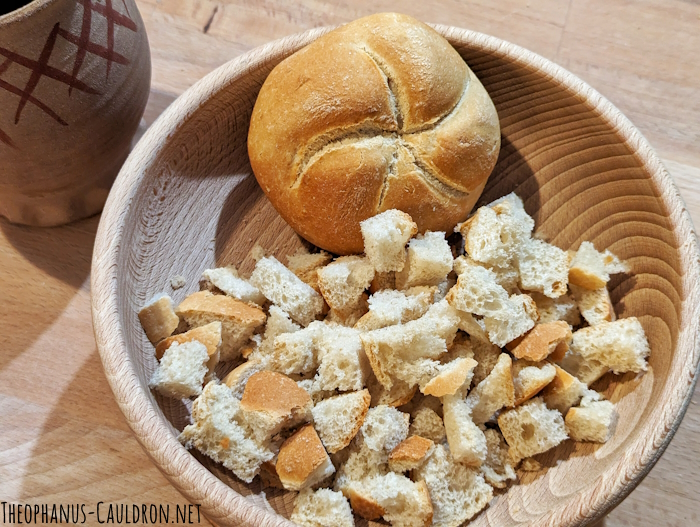
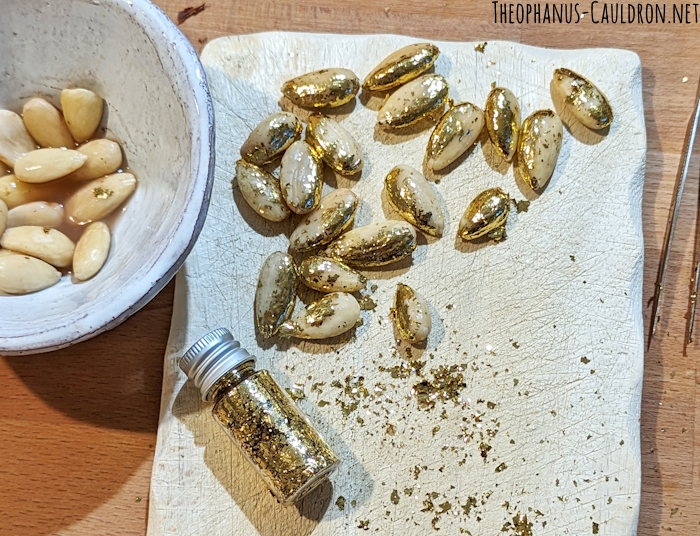
Rechproten in der vasten
The staff at the KochKulturMuseum were kind enough to send me their transcript and the translation of the recipe text.
Original
Source: (Küchenmeisterei, 1490, part 1, recipe 2)
Item wiltu ein holbroten oder genant eine rechproten in der vasten mache, nym feigen weinper erwelle sy in gute wein hacks klein sehmel darein vermisch es wol. mach es ab mit saltz vnd mit wurtzen. Netz dy hend in eine teigwasser slach dy feigen vmb eine spis als eine holprote mit nassen hende vn truck yn wol an lege yn zu de feuer. so er nun gebroten ist so schneid yn nach der leng auf an beiden seyten am spis mach hubsche stuck doraus vnd besteck sy mit madelkern vergult oder geferbt vnd gib es dar. Du magst zucker dorauff sehen oder frische ynguer. den brote begeust man auch mit milchsmaltz.
Translation in modern German
Willst Du einen Hohlbraten oder einen sogenannten Rehbraten in der Fastenzeit machen, so nimm Feigen und Weinbeeren und koch sie in gutem Wein. Gib kleingeschnittene Semmeln dazu und vermische es gut. Schmecke es mit Salz und Gewürzen ab. Befeuchte die Hände und schlag die Feigen mit nassen Händen um einen Spieß wie einen Hohlbraten und drück ihn gut an und leg ihn zum Feuer. Wenn er dann gebraten ist, so schneide ihn der Länge nach auf beiden Seiten am Spieß entlang an. Mach hübsche Stücke daraus und besteck sie mit vergoldeten oder gefärbten Mandelkernen und serviere es. Du kannst Zucker oder frischen Ingwer darauf streuen. Den Braten begießt man auch mit Milchschmalz.
My translation into English
If you want to make a hollow roast or a so-called venison roast during Lent, take figs and grapes and cook them in good wine. Add chopped rolls and mix well. Season it with salt and spices. Wet your hands and, with wet hands, wrap the figs around a skewer like a hollow roast and press it well and put it on the fire. Once it’s fried, cut it lengthwise on both sides of the skewer. Make pretty pieces of it and decorate them with gilded or colored almond kernels and serve. You can sprinkle sugar or fresh ginger on top. You also baste the roast with milk schmaltz.
Below I have marked the corresponding place in the scan of the 1486 edition and posted it as a photo.
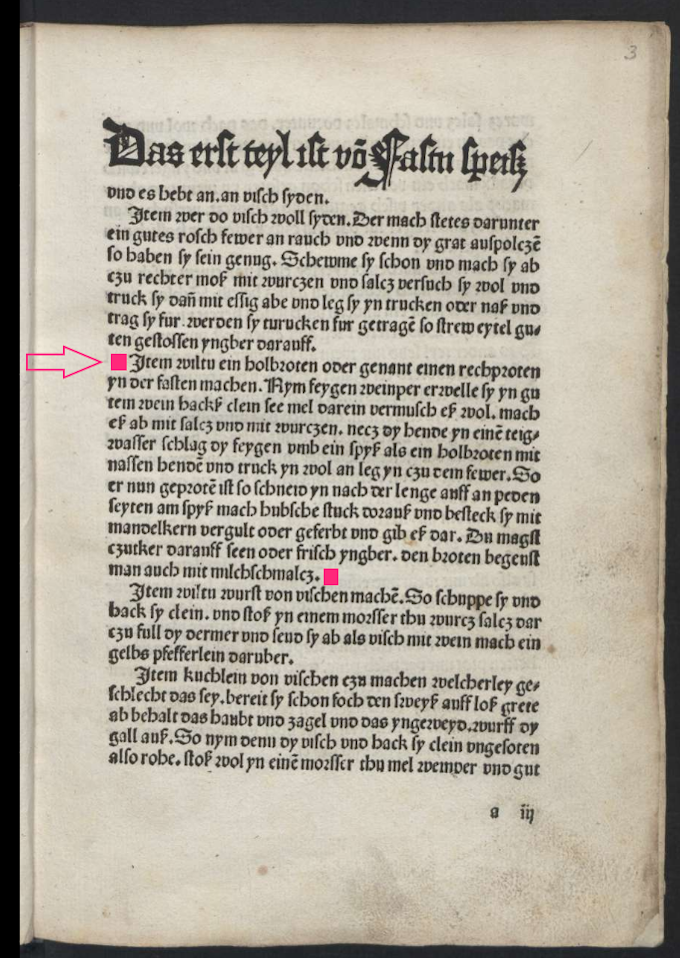
Thoughts and reflections on the fasting recipe from the late Middle Ages
–> So first of all: In my opinion, my sweet roast made from dried fruits and with gilded almonds as fake bacon strips actually looked great. I really can imagine the dish on an upscale table.
–> Since my child was eating with me, I used apple juice diluted with water (ratio 2:1. I think sour or dry wine could break up the brutal sweetness of the dried fruits a little more and contribute greatly to the taste of the dish. I haven’t used grape juice because of the strong sweetness.
–> I’m wondering whether I didn’t put enough bread in it (consistency, sweetness) or whether I didn’t knead the mixture long enough – my mixture slipped off the skewer (if I post a video about this on my YT-Channel , you’ll probably see that 🙈). Maybe the skewer was just too thin? KoKuMu had pointed out in their challenge, that one could also form small roasts and bake them that way, so that was my plan B.
–> How was the result?
Smell & Taste: It smelled amazing. Caramelized, fruity-fragrant, spicy. Also cakey thanks to the bread rolls. But it was incredibly sweet. Maybe more bread in the dough would have helped? I’m also wondering whether more spices would be useful. They faded into the background behind the all-powerful sweetness, but you could taste them. It was okay for our modern palate, but does it come close to medieval standards? There is a theory going around that they weren’t as potent because they had these very long transport ways and weren’t really sealed very good back then and that’s why they used bigger amounts of spices.
In any case, baking creates a delicious, caramelized crust on the dried fruit roast. But you just can’t eat much of it. After just one bite, we wanted a neutral cream sauce or unsweetened vanilla ice cream. Good thing I didn’t take advantage of the option to have sugar sprinkled on top. In fact, the fake roast venison tastes very good as a sweet spread on bread, as topping on porridge and also with a piece of cheese – like fig jam. The rest is now in jars and will be used up little by little and may end up chopped up in mince pies.
Consistency: The dough is surprisingly light, even after baking, but still held together well enough so it was easy to transfer the loafes from the baking pan to a plate (thanks to the clarified butter!). After cooling, the consistency will solidify slightly. (I was tempted to cut the dried raisins smaller so the dough would hold together better, but I thought that by roughly cutting up the figs I was doing more than the recipe called for.)
–> Personally, the vegetarian roast venison reminded me very much of modern, sweet recipes for British bread pudding with raisins and other dried fruits. What does it also remind me of? The fasting dish Lenten Slices (recipe 192) from the Viandier*, a French cookbook from the 14th century with recipes for the court kitchen. Although almond milk is used here instead of wine, I personally recognize a similarity in terms of content.
–> In addition to options such as fresh ginger, sugar for sprinkling and clarified butter for basting/brushing, the recipe also offers two expensive variants for the almonds: gold leaf or coloring. Saffron* would probably have been the most obvious and simpler application here. Saffron is mentioned in the manuscripts for coloring food. Regional alternatives such as cornflowers (blue) are also explained. I chose edible gilding*. (Since I chose flakes to gild the almonds, they were a bit difficult to apply with tweezers due to their small dimensions, which is why I – and my child who helped me – then rolled the almonds in the gold flakes on a board until they stuck. Finally, I smoothed/polished them with a finger. As a result, we had gold speckles on our faces, on our clothes and beautifully polished and laid in speckles on the wood of the work surface (the board was already a lost case anyway). Despite washing, the gold speckles kept meandering through the kitchen in the following days. But I look at it this way: There is never enough sparkle and glitter in life. 😅)
–> The result of this experimental archaeological cooking experiment is of course also nice for people who spend their time in the field of reenactment and living history. I hope my recipe interpretation inspires others.
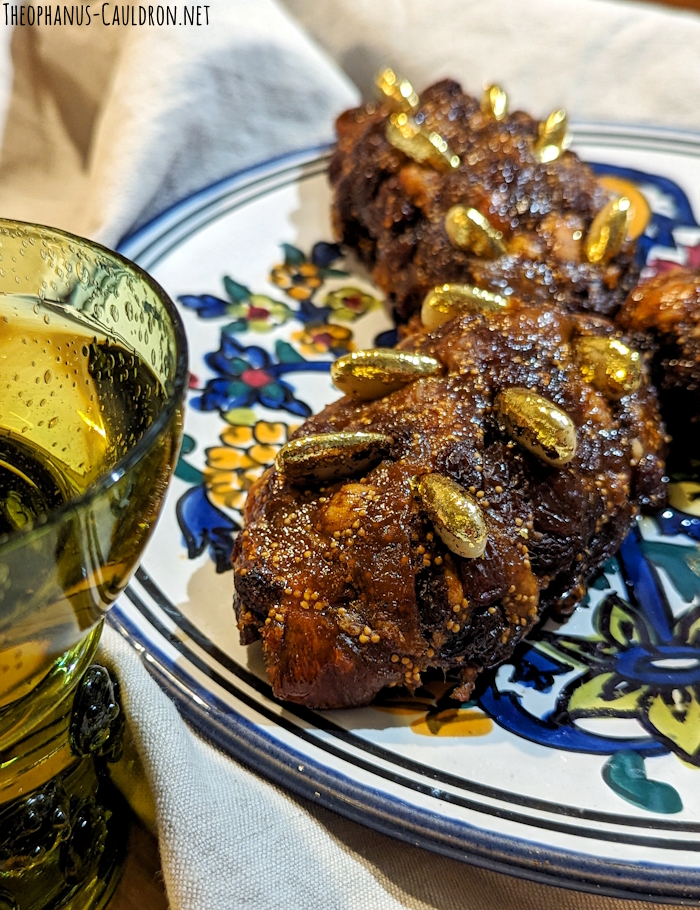
Recipe for a sweet, medieval Lenten dish from the 15th century Germany / fake venison roast [Holbroten/Rechproten in der vasten]
250 g figs (dried)*
250 g raisins (dried)
400 g apple juice and water mixture (mixing ratio 2:1 = ~266g apple juice, 122 g water – original: wine)
75 g stale, white rolls
30 whole almonds*
3/4 tsp ceylon cinnamon*
3 cloves
1/8 tsp mace*
1/4 tsp ginger (dried)
10 grains of black pepper
2 tbsp clarified butter
edible gilding*
preparation
- Crush/grind all spices finely in a mortar.
- Quarter the dried figs and put them in a pot with the raisins, juice (or wine) and spices, bring to the boil and then simmer gently over a low heat for 15 minutes. The figs and raisins should be cooked soft and juicy.
- Cut the stale rolls into small cubes and fold them directly into the still hot fruit mixture.
- Allow the fruit-and-bread-mixture to cool for 30 minutes.
- Put the mixture in a bowl and knead with your hands until you get a nice (and rather sticky) dough.
- Wet your hands with water and form small roasts around a skewer and place in a baking dish. (Didn’t work for me.) Alternatively: Melt about 1 tablespoon of clarified butter and pour/brush the bottom of a baking dish with it. Wet your hands with water and form three elliptical loaves from the dough and place them in the baking dish.
- Now bake the fake venison roasts in the oven at 175 °C (347 °F, preheated, fan oven, middle rack) for 25-30 minutes.
- Meanwhile, put the almonds in a pot, bring to the boil briefly, let them cool and then remove the skin. Cover the almonds with the gold leaf/gilding agent of your choice. I only gilded one half of the almonds because the other half won’t be visible because its in the pastry.
- Use a spatula to remove the dried fruit roasts from the baking dish and place them on a plate.
- Press the gilded almonds into the roast. Think of strips of bacon that you put through a roast venison. I placed 6 almonds per piece of pastry: lying on the side and always 2 parallel to each other, see photos.
- Melt a tablespoon of clarified butter and pour it over the three loaves – between the almonds – and brush if desired. Serve.
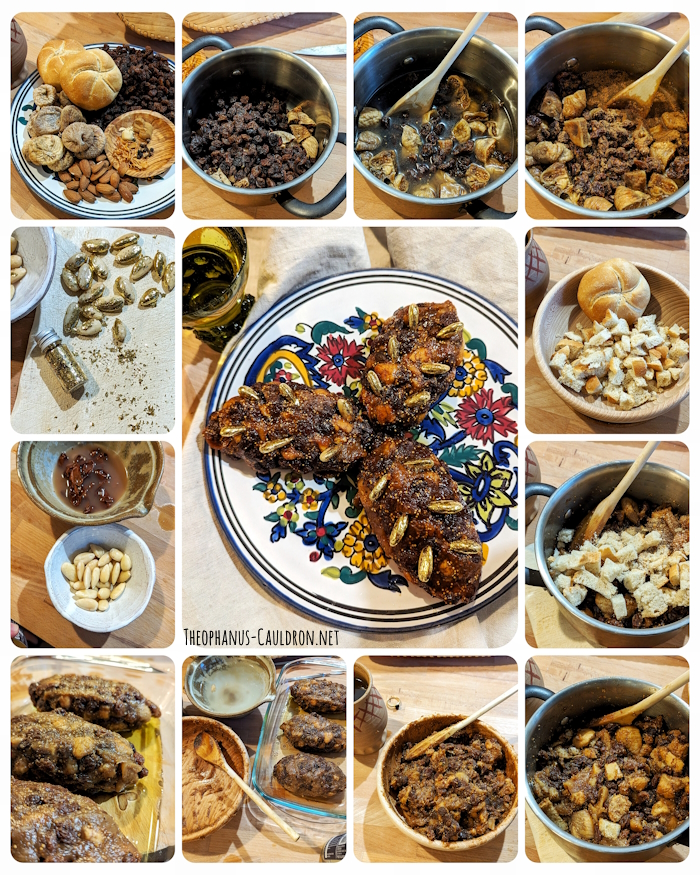
*Ad/Werbung. As an Amazon Associate I earn from qualifying purchases. Afiliate-Links zu Amazon. Bei einem Kauf hierüber erhalte ich eine Vergütung.
You want to read this article in German language? Go to my foodblog “Der magische Kessel“.
If you like my research articles and recipes, I would be very happy about your support. You can back me up monthly via Patreon or simply buy me a “coffee” via Ko-fi. Thank you for your appreciation of my work! Your actions feed my work and my blogs! ![]()

